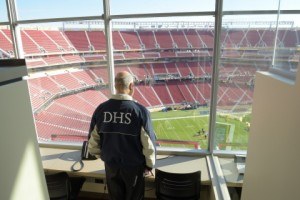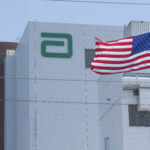Levi Stadium’s regular capacity of 68,500 seats has been expanded to 75,000 in anticipation of Sunday’s Super Bowl game, scheduled to begin at 3:30 pm Pacific time.Millions of football fans are expected to descend on the San Francisco area in anticipation of the game and local, state and federal safety officials are ready.
According to Harry Rhulen, chairman and CEO of Firestorm, a national company specializing in emergency response and crisis management, months of preparation have gone on in anticipation of this event.
“The Super Bowl is considered what they call a national security venue and that means it gets the highest level of priority from Homeland Security, Secret Service. They all do a comprehensive plan that involves not just the venue itself but the entire city, the air traffic patterns, all of that stuff is all integrated into a plan and they’ve been working on that plan for months. It’s a very substantial undertaking that they go through,” Rhulen said.
The stadium’s website offers information on safety restrictions. For example, tailgating won’t be allowed in any Super Bowl 50 parking lot and there won’t be any bus, limousine, sedan or shuttle drop off or pick up near Levi’s Stadium. Even Ubers and taxis must pick up and drop off a distance away from the stadium.
According to the National Business Aviation Association, there’s a 30 or so mile no fly zone centered around Levi’s Stadium on game day. Drones have a wider restriction at 35 miles.
There are numerous risks in hosting a massive event like the Super Bowl, said Eric Boyum, a Denver-based technology and telecommunications national practice leader at Aon Risk Solutions. These include the regional specific risk of an earthquake, since the game will be played in a seismically active area. Given the stadium is new, it’s likely it has the latest seismic protection, added Boyum. According to a 2014 news release issued after an earthquake was reported on the same day, the California stadium meets the state’s seismic code requirements. The press release noted that seismic bracing was incorporated into the design and construction of the stadium which opened to fans in August 2014.
Another obvious risk is a terrorist attack.
“That would create the most catastrophic consequence to the Bay area, certainly to the stadium, certainly to the NFL and its related franchises,” said Boyum.
A joint Department of Homeland Security/Federal Bureau of Investigation warning focused on two other risks, said Boyum. One issue related to the potential physical damage to fiber optic or copper cables that could impact bandwidth and the ability to broadcast and observe the game. The second issue related to the use of drones.
There is some new technology that may be used to monitor security during the Super Bowl, said the Aon practice leader. New high definition security cameras can be used to do searches on key words based on alerts, such as ‘be on the lookout for a red Jeep Wrangler’. In addition, a product called ShotSpotter offers a way to recognize gunshot sounds via listening devices.
Despite all of the preparation to thwart risks, Rhulen said the problem is that officials can’t anticipate what might be coming next. Technology is primarily to blame, he said.
“…The biggest problem for the insurance industry and the biggest risk to the United States as a whole is what I call rate of change, so because of technology – the things that are changing everyday – we can’t keep up with it, we can’t necessarily anticipate what’s coming next,” Rhulen said.
NFL security and law enforcement officials deny a credible threat to Super Bowl 50.
Jeffrey Miller, NFL senior vice president of security, said during a press conference this week that he is satisfied with the collaborative effort between local, state and federal law enforcement agencies to handle any possible issues, including terrorism of any kind.

“Every year is different.The world situation, the threat picture is different every February,” said Homeland Security Secretary Jeh Johnson. “We are, with the NFL, with our federal partners, and state and local law enforcement, focused on layered security, seen and unseen. We learned from events of the past but we have to protect against events of the future. So, we try to anticipate things that can happen from multiple different directions. But we’re always informed by recent events and what we see in the world situation.”
Johnson said intelligence has picked up no troubling signals so far.
“Dozens of federal agencies and components, including multiple components of the Department of Homeland Security, are contributing to security measures seen and unseen in connection with the Super Bowl,” said Secretary Johnson. “Within the Department of Homeland Security itself, TSA, CBP, ICE, Coast Guard, the Secret Service, FEMA, our Office of Intelligence and Analysis, and our National Protection and Programs Directorate are contributing to the security of this event.”
The FBI opened a multi-agency command post last week about six miles from Levi’s Stadium that will be continuously staffed through Sunday.
The DHS issued a press release a few days ago that provided details on the roles each agency and organization will play with respect to protecting public safety. Some examples: the TSA has sent 100 more officers and specialists to work the surrounding airports, the Secret Service plans to monitor social media, the U.S. Coast Guard plans to provide maritime security and the U.S. Customs and Border Patrol and ICE will provide extra security at several venues and will monitor for counterfeit products. In addition, FEMA plans to have mobile emergency response units on hand at the stadium and the Office of Health Affairs will monitor for any biohazard contamination. Bomb and active shooter threats have also been considered.
Johnson added that public awareness will be important too, referring to the “If You See Something, Say Something” campaign. This year, messaging highlighting how everyday citizens can help by identifying and reporting suspicious activity using mobile applications will be visible to more than 15 million fans in the San Francisco area.
“At this time we know of no credible threat directed at Super Bowl 50,” Johnson said.
“It gives the NFL a great deal of confidence in the safety of our premiere event, our teams and our fans,” Miller said at a news conference Wednesday.
With all of the security on hand before and during the event, Rhulen said that the stadium isn’t a soft target.
“Typically terrorists, people who are bent on doing harm they look for soft targets,” said Rhulen. “They don’t look for the organizations that are prepared and there’s probably no organization that’s prepared better than the Super Bowl.”
Janie McCauley and Paul Elias, Associated Press writers contributed to this article.
Was this article valuable?
Here are more articles you may enjoy.

 Flooding in California Leads to Soaked Roads, Water Rescues and 1 Death
Flooding in California Leads to Soaked Roads, Water Rescues and 1 Death  ‘Door Knocker’ Roofers Were Everywhere. NC Farm Bureau Saw an Opportunity
‘Door Knocker’ Roofers Were Everywhere. NC Farm Bureau Saw an Opportunity  Tesla Drivers Are Buying Escape Tools and Cars to Avoid Getting Trapped Inside
Tesla Drivers Are Buying Escape Tools and Cars to Avoid Getting Trapped Inside  Abbott Presses Congress for Shield Over Preemie Baby Formula Litigation That Could Cost It Billions
Abbott Presses Congress for Shield Over Preemie Baby Formula Litigation That Could Cost It Billions 